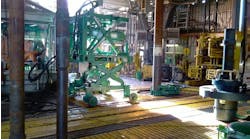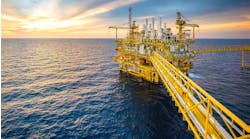Victor Schmidt
Houston
The CGG Fohn delivered a 1,300 sq km migrated 3D survey within two days of final acquisition offshore Congo.
- Western Geophysical's Western Legend set a new data delivery record for Indonesia [20,072 bytes].
- Fugro-Geoteam A/S has LOS '97 available for Lithuania's licensing round [48,187 bytes].
Technology slashes 3D seismic delivery times
CGG Marine delivered a final 3D migrated-stack datacube in less than two days after acquisition. The offshore Congo survey was a joint project between Esso and Shell. The M/V CGG Fohn gathered the 1,300-sq-km survey using six 4,500-meter streamers with a total spread of 500 meters. Final bin size was 12.5 meters by 25 meters with 45 fold.The data were processed onboard then transmitted via satellite to Shell's Congo offices. D. S. Davidson, Chief Geophysicist of Shell Congo B.V., stated: "I believe this achievement clearly demonstrates the value of good quality onboard processing and the business impact of good communications."
Shot, processed and delivered
Western Geophysical's Western Legend set a new data turnaround record in Indonesia. A 1,800-sq-km fully processed data set was delivered to Conoco in 27 days. The prior turnaround record was 70 days. This record was achieved by processing the data set entirely onboard. "Four data volumes and the use of cross-line trace interpolation resulted in a staggering 600,000 CMP km of seismic data for the final 3D migrations," explained Chuck Toles, Vice President for Far East, Australia and China for Western. "Our interpreters are extremely pleased with the data," said Mark T. Wheeler, Vice President and General Manager of Exploration for Conoco. The survey was part of the West Natuna Sea gas field development.Lithuanian survey now available
Fugro-Geoteam A/S has the Lithuanian offshore seismic survey (LOS '97) available for purchase. The 1,030-km 2D survey was gathered late last year by the M/S Geo Scanner and augments earlier surveys in the Baltic Sea. For information, contact Nils Engelstad in the UK at Tel: (44)-22-13-46-00 or Fax: (44) 22-13-46-46.Shallow PNG 2D survey
Oil Search contracted GeoMarine to conduct a 3,500-km 2D seismic survey off Papua New Guinea. The shallow-water survey is being conducted by the GeoMariner 1 in water depths as little as four meters. The work is being done using a single 3,000-meter streamer with 1,000 cu in. airgun array.Deep Gulf reconnaissance
TGS-Calibre and CGG have begun a new 36,000-mile 2D seismic survey in the deepwater Gulf of Mexico. Phase 47, an extension of Phase 45, will collect data in Walker Ridge and Lund areas. Water depths across the survey areas are in the range of 10,000-13,000 ft. CGG brought the Mezen to the Gulf from Europe to collect the data using an 8,000-meter streamer system. "With Phase 47, we will help the industry to expand the frontiers of Gulf of Mexico deepwater exploration," explains Hank Hamilton, CEO of TGS-Calibre.Grand Banks survey
Geco-Prakla won a contract for a 1,000-km 3D survey south of Hibernia Field. Partners Petro-Canada, Chevron Canada Resources, Mobil, and Norsk Hydro scheduled the survey for this summer. The vessel Geco Orion will gather the data using eight streamers and two sources.Making sense of MWD
Tensor has released its new Logview software for Tensor's geosteering tools and QDT's measurement-while-drilling (MWD) systems. The software operates under Windows 95 or Windows NT and permits data editing in a graphical environment. For information, contact Aubrey Holt of Tensor in the US at Tel: (512) 251-4131 or QDT at Tel: (512) 251-8465.Connect and process
Schlumberger Geco-Prakla has launched SeisConnect, a networked seismic processing service. Within a company's facilities, Geco provides a geophysicist with processing experience and a workstation with network connections to the processing hub. Seismos data analysis system is used to conduct bulk processing operations through the network. The new service offers greater project control through a scaleable, local and accessible processing service. For information, contact Mike Standish in the UK at Tel: (44) 1293- 55-6150 or E-mail: [email protected]Software improves view of fluid motion
Flow Science, Inc. released Version 7.1 of its FLOW-3D computational fluid dynamics software. The new version introduces a graphical user interface (GUI) for ease of use and a sterolithography file viewer for checking imported geometries. The new GUI has the same appearance on both PC and UNIX platforms so users may move freely between them. For informaion, contact Flow Science in the US at Tel: (505) 662-2636 or Fax: (505) 662-6564.Cold gas to warm Japan
Gas hydrates are a future energy source occurring naturally in water depths of 300 meters or more and in deep permafrost areas of the Arctic. The volume of methane hydrates will likely exceed all known conventional hydrocarbon sources. The Japanese National Oil Company (JNOC), Japex, and the Geological Survey of Canada (GSC) are conducting a research project to evaluate the potential of methane hydrate exploitation as an unconventional energy resource.JNOC conceived the research program with the idea of developing hydrate resources off Japan. The partners are drilling a test hole, Mallik L-18, to a planned depth of 1,140 meters. The well is located on Richards Island in the Mackenzie Delta 150 km from Inuvik, Canada. Planned tests include: coring over a hydrate interval (900-1,032 meters), geophysical well logs, and a drill stem test. JNOC, Japex, GSC, and USGS will be conducting scientific studies on the cores.
The project began in 1995 and will culminate with a test well offshore Japan in 1999. This well is to be drilled in either the Nankai Trough or Okhotsk Sea. More complete information is available at the GSC website, http://sts.gsc.nrcan.gc.ca.
Copyright 1998 Oil & Gas Journal. All Rights Reserved.




